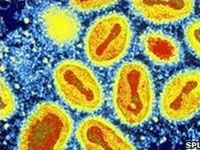随着天花在全球消失,天花疫苗已经在全球停止接种,但美国科学家最新研究发现,接种天花疫苗可能有效预防艾滋病传播。如果这一研究成果得到证实,将使艾滋病防治工作进入一个新的阶段。
这一研究是由美国加利福尼亚大学洛杉矶分校以及乔治梅森大学的研究人员共同完成的。研究人员对曾经接种天花疫苗和没有接种天花疫苗的人进行了分析对比。
结果发现,接种天花疫苗的人要比没有接种天花疫苗的人更能有效抵御艾滋病病毒侵袭,后者感染艾滋病病毒的几率要比前者高5倍。
负责这项研究的乔治梅森大学科学家雷蒙德魏因施泰因说,关于目前艾滋病蔓延的解释有多种,其中包括战争、重复使用没有消毒的针头等。此次的研究却在一定程度上证明,停种天花疫苗与艾滋病蔓延之间可能存在关系。
有关成果刊登在5月号《BMC免疫学》(BMC Immunology)杂志上。
原文出处:
BMC Immunology 2010, 11:23doi:10.1186/1471-2172-11-23
Significantly reduced CCR5-tropic HIV-1 replication in vitro in cells from subjects previously immunized with Vaccinia Virus
Raymond S Weinstein , Michael M Weinstein , Kenneth Alibek , Michael I Bukrinsky and Brichacek Beda
Background
At present, the relatively sudden appearance and explosive spread of HIV throughout Africa and around the world beginning in the 1950s have never been adequately explained. Theorizing that this phenomenon may be somehow related to the eradication of smallpox followed by the cessation of vaccinia immunization, we undertook a comparison of HIV-1 susceptibility in the peripheral blood mononuclear cells from subjects immunized with the vaccinia virus to those from vaccinia naive donors.
Results
Vaccinia immunization in the preceding 3-6 months resulted in an up to 5-fold reduction in CCR5-tropic but not in CXCR4-tropic HIV-1 replication in the cells from vaccinated subjects. The addition of autologous serum to the cell cultures resulted in enhanced R5 HIV-1 replication in the cells from unvaccinated, but not vaccinated subjects. There were no significant differences in the concentrations of MIP-1alpha, MIP-1beta and RANTES between the cell cultures derived from vaccinated and unvaccinated subjects when measured in culture medium on days 2 and 5 following R5 HIV-1 challenge.
Discussion
Since primary HIV-1 infections are caused almost exclusively by the CCR5-tropic HIV-1 strains, our results suggest that prior immunization with vaccinia virus might provide an individual with some degree of protection to subsequent HIV infection and/or progression. The duration of such protection remains to be determined. A differential elaboration of MIP-1alpha, MIP-1beta and RANTES between vaccinated and unvaccinated subjects, following infection, does not appear to be a mechanism in the noted protection.








